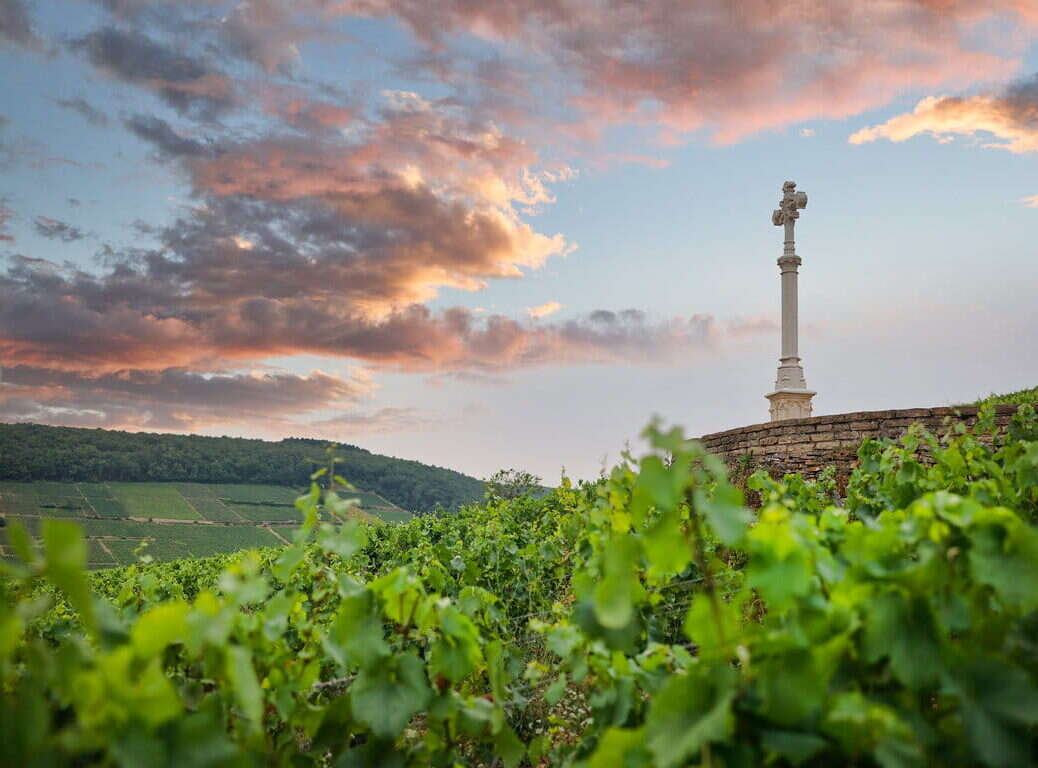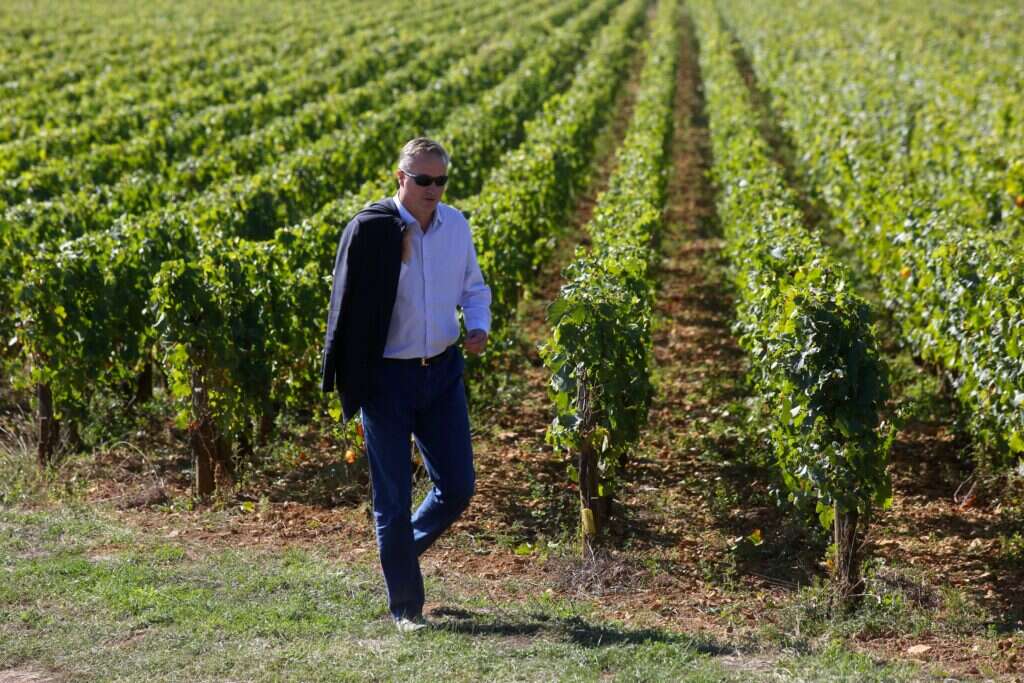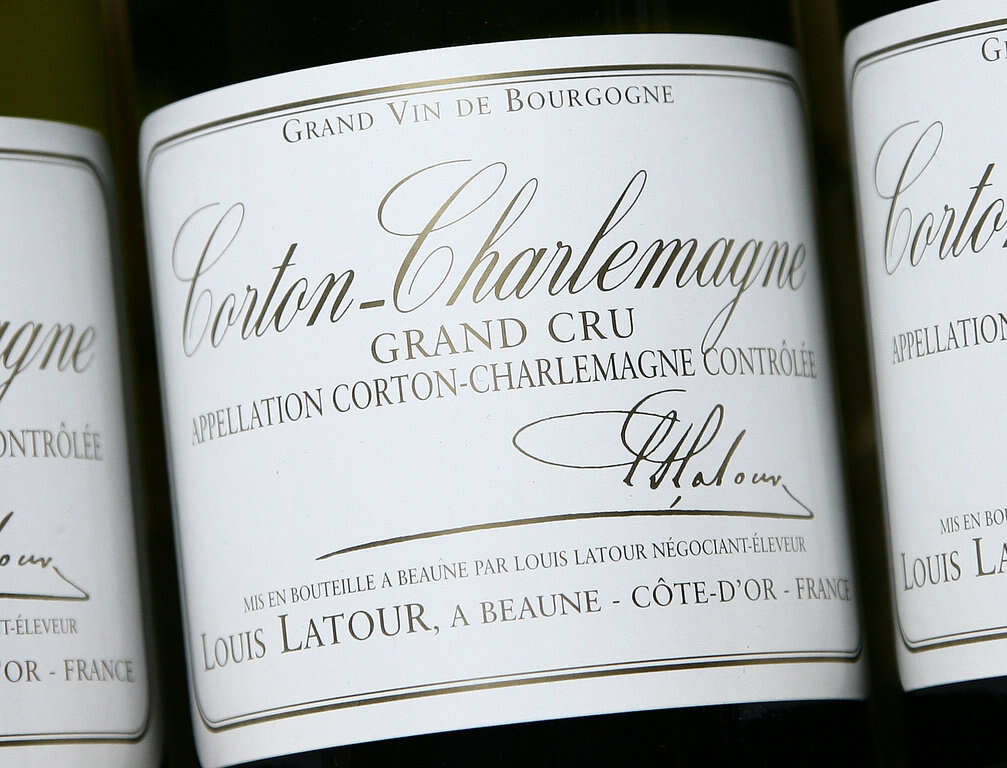
According to Jean-Charles Thomas, Head Winemaker for Louis Latour, “Corton-Charlemagne is one of the real beneficiaries of climate change. While we see stress in Montrachet, in these recent dry vintages the Corton hill has plentiful springs. The gray and yellow marls retain more water than thinner rocky limestone, so vines can ripen happily without stressing and blocking.”
I joined Thomas and Louis Latour’s Managing Director Christophe Deola for a vertical of their Corton-Charlemagne. The last time I tasted a vertical at the company’s elegant headquarters in Beaune was with Louis-Fabrice Latour. Louis-Fabrice also had climate change in mind when he selected Meursault Blagny Premier Cru to contemplate the impact of warmer summers on this up-slope terroir. Very sadly Louis-Fabrice has since passed away, but I am sure he would have been as pleased as I with the choice of Corton-Charlemagne for this tasting in his memory. The hill of Corton is the heartland of Domaine Louis Latour where the family own an immense 26.59ha (65.7 acres) of white and red grand cru making them the largest owner by a long chalk. And it was here that I came to shadow winemaker Denis Fetzmann at Louis Latour’s Château Corton Grancey in Aloxe-Corton back in 1998 to gain experience in winemaking the Burgundian way.
The domaine’s Corton holdings include 10.5ha (26 acres) of Corton-Charlemagne which are scattered across many parcels including west-facing Le Charlemagne, south-facing Les Pougets, and neighboring Languettes. A further 1.5ha (3.7 acres) lies around the hill in east-facing Renardes, which is the last section to be picked in a harvest that spans seven days.
Within the climat of Le Charlemagne, the vines situated mid-slope are harvested first. “At the bottom it is almost flat, so we pick this second for it has more water which delays the ripening,” remarks Thomas. “The very top of Le Charlemagne is cooler and there is more limestone in the grey marl. It takes time to ripen.”
Also higher on the slope is Languettes, but this stony and well exposed site ripens very quickly, especially in recent vintages. To mitigate these effects of warmer and drier summers Thomas has been experimenting with soil and canopy management and—in contrast to the trend for higher canopies—favours reducing the leaf surface. “We want to decrease the evaporation from the leaves and felt the vines were more stressed with higher canopies. We also want to limit photosynthesis to decrease sugar. We are in the fourth year of trials de-leafing the top of the vines to decrease alcohol and their water needs.”
Louis Latour has also changed direction in the use of green manure—a practice where various plants, legumes, herbs, and grasses are seeded in the fall to be plowed into the soil in spring to enrich it. “It has a lovely effect on the soil, but even if we mulch in March and April, it takes too much water,” explains Thomas.
Have there been any other significant changes? “Changes are more about the timing of harvest, than anything in the winery,” says Deola, who, as well as being the MD, is also an enologist and engineer. “Louis-Fabrice Latour liked a rich fleshy Corton-Charlemagne so we would wait for full ripeness when the seeds are brown. We were always looking for a minimum of 13%. Maybe now we are looking for phenolic ripeness and are not so concerned to get the alcohol.”
A good all-round expression of Corton-Charlemagne
Louis Latour’s Corton-Charlemagne, by virtue of the many parcels it incorporates, is a good all-round expression of the grand cru, although it’s fair to say it leans into a richer oaky style. “Now we are working on more tension,” says Deola, “and over the past ten years we have decreased the ageing in barrel by about two months.”
“Of course we adapt each year depending on vintage.” This includes dealing with higher ambient temperature at harvest. In 2022 this exceeded 30°C (86°F) so Thomas used dry ice in the press to cool the grapes. After pressing he looks for 350 NTUs of turbidity. “This is the magic figure for purity of flavour with sufficient phenolics but with no herbal notes. We need enough to support a perfect alcoholic fermentation and allow nice ageing on lees without stirring. We have about 8–10cm (3–4cm) of sediment in a barrel, where the wine stays for eight to ten months. We have never done bâtonnage. That’s a constant.”
Thomas uses a non-aromatic cultured yeast. “Some indigenous yeasts are struggling now with global warming.” He prefers a guaranteed fermentation and adds, “With a neutral yeast you can still see the terroir.” He also likes the security of starting the fermentation in tank before moving the wine to barrel with a density around 1045. In barrel the temperature naturally increases from 18–20°C (64–68°F) to 20–22°C (68–72°F). “This is a good temperature to extract flavors,” observes Thomas. “Higher than this and the flavors are rough.”
For the oak, about 90% is new, and Deola tells me “We like pièces [traditional 228-liter (60-gallon) Burgundy barrels] and prefer to work on texture from the oak rather than different forests and sizes, so we have light long toast for 45 minutes to achieve sugary components to give more fat and body to the wine.”
The Corton-Charlemagne is racked into stainless steel tanks sometime between May and June following harvest where it settles and is bottled between December and February. Thomas uses bentonite, but no casein. The 2022 vintage will be bottled under diam 30. “Louis-Fabrice wanted to find a solution with cork, but in 2022 everything will be bottled under diam. The problem with cork is not TCA, but porosity.”
After we tasted the vertical Deola remarked, “Louis-Fabrice really liked the 2016, but for him 2018 was the perfect combination—a good volume, an American taste profile, and it is approachable young, so it was great for restaurants. He prefered 2017 to 2018, but felt 2018 was more impressive. He saw things from a commercial viewpoint, not just as a wine geek. He would always say the current vintage was the best—better than the last and not as good as the next!”
Here’s to you Louis-Fabrice.

Tasting Louis Latour Corton-Charlemagne
Corton-Charlemagne 2022
This had been recently fined when I tasted it but had a pleasant lemony aroma and plenty of richness on the attack. Lively acidity with a fruity, citrus slice through the concentration and smooth minerality to finish. 94+ 2027-40
“We started harvest on the August 26, but we were ready to harvest 92 days after flowering,” remarks Thomas. The old rule of thumb was 100 days from mid-flowering to harvest. “Often now in hot vintages it is 90 days, but because of the drought the vines stuck. All the stomata closed. We picked a week later than expected at 104 days.”
Corton-Charlemagne 2021
Cool and reserved aroma with hints of cucumber and dill. Slim and trim glide. Pure. Savory; lactic acidity. The cooler season shows in the fennel notes and super crisp edges. Lively dry minerality to finish. 94 2027–36.
“Tiny yields, just 10-15% of a full crop. We finished harvesting whites at the beginning of October, after the reds, as whites struggled to ripen. We’ve never done such a long harvest for such a small crop, but it allowed us to get the ripeness,” explains Thomas. “Old school cold season with this acidity and dry extract,” comments Deola.
Corton-Charlemagne 2020
Aroma of buttery brioche with a hint of singed toast. Caramel-rich generosity on the attack. Splashing ripe fruit and exuberant freshness to the full bodied palate. An abundant wine with high concentration of fruit and equally high acidity. The oak and ripeness combine to make a glossy wine, but one with plenty of tension. The finish is vigorous and persistent. 96/7 2030-45
“With high acidity and dry extract, it will age well. Maybe like 2010,” says Thomas. “A big baby with lots of concentration but lots of acidity; powerful and round,” adds Deola.
Corton-Charlemagne 2019
A touch of secondary notes on the aroma. Toast and grilled hazelnuts with caramel, orange zest and cinnamon. Gentle onto the palate with warm bready notes, where it expands to become rather ample. A soft and open feel with a loose, grainy texture. It’s appealing, succulent, and a touch exotic. Not the depth and balance of a top vintage, nor is the finish as pure or as long. 93 2024-32
“A good season, but we had drought and the vines suffered so we didn’t get the phenolic maturity for reds or whites. So a very nice vintage, but not as good as we were expecting,” says Deola.
Corton-Charlemagne 2018
Buttery croissant with a hint of mint and caramelized sugar on the aroma. Showing some evolution. It’s both more compact and focused than 2019. It certainly has breadth; so broad and straight with medium depth, between 2019 and 2020. Enough acidity with a feeling of high dry extract instrumental in the balance. Graphite minerality on the finish, which is of similar length to 2021, but there is only moderate energy. I feel there is less ageing potential here. 94 2023-32
“2018 was the first vintages with impressive power and density,” says Thomas.

Corton-Charlemagne 2017
Delightful, succulent aroma with a waft of fresh hay. Sweetness and generosity up front, but delicately done. This is an elegant, lighter-bodied wine with similar weight to 2021, but with much more sweetness, roundness, and intensity. Lovely balance of fruit and acidity. This has an easy harmony and fluidity. It ripples into a silky-sweet mineral finish. Pure, translucent, and precise. No hurry to start this wine; wait a year or two. Maybe a bit like 2007 for ageing. I really liked this wine. 96 2025-40
“A good surprise in fact. Enough shoulder for grand cru, but that was not evident at harvest time. 2017 weather conditions were not so sunny and we had some rain. It is a good wine, old school, like a vintage at the end of 80s,” remarks Thomas. “There was a smaller crop in white than red in 2017 and it was better than we thought,” confirms Deola.
Corton-Charlemagne 2016
A great deal more evolved than the 2017. The color was a giveaway, but the aromatics of Marmite, old Parmesan cheese, and beeswax showed significant evolution. It has some weight and opulence. Full-bodied, impressive for its baroque golden feel, but seems low in acidity and energy. Vanilla creme brûlée finish. It’s rather clunky and the finish is shorter than 2019. Could be a cork issue. However Thomas and Deola thought it was much better than I did. 90 2023-30
Thomas comments, “There was no disease, a medium crop and later harvest in October as the frost delayed everything. More classical, lots of dry extract and like 2010 for concentration.” While Deola finds the 2016 “Elegant and refined. Very concentrated. In this cool ripening season, we have high acidity and good phenolics. Maybe without the frost it would have been like the warmer 2019 and 2020 vintages.”
Corton-Charlemagne 2015
Bright and inviting and so fresh comparison with 2016, despite being a hot vintage. Fresh hay, dried apricot, and honey, and a peppy salty note. The palate recalls memories of summer at the seaside: salt, sun, and wild flowers. It’s full and rounded, but not heavy. Sunny, but certainly fresh enough. The exotic aromas associated with the 2015 have mellowed into warm ground coriander. The finish is rather well sustained. 2015 has slimmed and gained some poise. I was surprised at how well it has evolved. 95 2023-35
“2015 is like 2005, a ripe and maybe flabby vintage. No-one thought a lot of these two vintages. 2005 never shows as we expect and changes each time we open it. The 2015 is open and ripe, powerful and fat, but fresh and has good length,” says Thomas. “It was closed for a long time and now it is a good surprise,” adds Deola.
Corton-Charlemagne 2014
Nutty, new-mown hay with a touch of gunflint. More evolved and less fruity on the aroma than 2015, however the palate is still super youthful and shows citrus fruit and silex. Finely wrought, delicate, and pure. Whips along, taut and lively; really fizzles on the finish where there is a touch of something herbal combined with oyster-shell. A light, precise, and elegant wine. You could afford to wait a few years since it should continue to evolve beneficially and I should imagine will plateau for some time. 96/7. 2027-40
Thomas finds it “very classical. Like the 2017 it was impaired by the vision of the reds but it is very good.” Deola remembers that “Louis-Fabrice said it is a vintage for English people.”
Corton-Charlemagne 2013
Touch of green banana skin and asparagus. It is light and lean. Sadly it is also rather dilute and short. 88.
“Like 2017 and 2014 the reputation of the whites was impaired by the reds. It was very difficult for farming as there was disease,” says Thomas. “We harvested at medium ripeness at the end of September. Delicate, yet closed are marks of evolution and reduction coming from the lees.” For Deola, it’s at “a good place in its life.”.
Maybe it was a shame to conclude with the challenging 2013 vintage, but this short flight contained many lovely wines some of which exceeded my expectations. And to revert to the Meursault Blagny Premier Cru mentioned earlier, that flight of 21 vintages included bottles from the 1990s among which 1999, 1996, 1990, and for that matter the 2000 were alive, kicking, and rather delicious. This illustrates the ageing potential of wine from a much more modest terroir in both warm and cooler vintages, which suggests a promising future for the Corton-Charlemagne 2020, 2017, 2015, and 2014 vintages that stood out in this tasting. But as I never tire of saying, white Burgundy can age longer than you might suppose.
Louis-Fabrice Latour (1964–2022): A life of service to the region he loved






